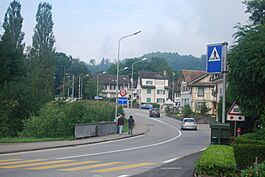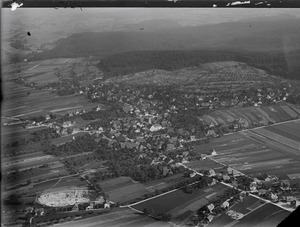Roggwil, Bern facts for kids
Quick facts for kids
Roggwil
|
||
|---|---|---|

Roggwil village
|
||
|
||
| Country | Switzerland | |
| Canton | Bern | |
| District | Oberaargau | |
| Area | ||
| • Total | 7.84 km2 (3.03 sq mi) | |
| Elevation | 421 m (1,381 ft) | |
| Population
(Dec 2020 )
|
||
| • Total | 4,176 | |
| • Density | 532.7/km2 (1,379.6/sq mi) | |
| Postal code |
4914
|
|
| Surrounded by | Aarwangen, Langenthal, Murgenthal (AG), Pfaffnau (LU), Untersteckholz, Wynau | |
Roggwil is a town, also called a municipality, located in the Oberaargau area of the canton of Bern in Switzerland. It's a place with a long history and has grown from a farming village into a busy industrial and service center.
Contents
History of Roggwil
Roggwil was first mentioned in old records in the year 949. Back then, it was called Rocchonuuillare.
Long before that, during the Roman times, people lived here. Archeologists have found Roman objects and parts of old buildings. In the Middle Ages, a fort on a hill called Chülperg protected the village.
A powerful family, the Barons of Bechburg, owned Roggwil. Later, a branch of this family even took the name "Roggwil." In 1194, when St. Urban's Abbey (a type of monastery) was founded, the Lords of Roggwil gave them land in the village. Over time, the Abbey bought more land and became the main owner and ruler of Roggwil by 1250.
In 1406, the city of Bern bought the area that included Roggwil from the Kyburgs. Bern slowly took more control. By 1413, Bern managed the local courts, which limited the Abbey's power. Roggwil was first part of the Amt (a local administrative area) of Wangen. Later, between 1580 and 1590, it moved to the Amt of Aarwangen.
After the French invaded Switzerland in 1798, Roggwil tried to join a new canton called Aarau. However, it was placed in the Bernese district of Langenthal. In 1803, it became part of the district of Aarwangen again.
The village church was first mentioned in 1201. It was a "daughter church" of the main church in Wynau. In 1664, Roggwil and some nearby areas formed their own church community. The current main church was built in 1664–65. Later, a Catholic church was built in 1973, and a New Apostolic Church in 1985.
In the 1700s and 1800s, more people started living in Roggwil. Many families began weaving at home to earn extra money, alongside farming. This was called "cottage industry." In 1857, a railway line from Olten to Bern built a station in Roggwil. This was a big change! Another smaller railway line opened in 1917.
The railways helped Roggwil become more industrial. A cotton factory opened in 1862, a brick factory in 1904, and a machinery factory in 1924. As factories grew, farming became less important. By 2005, manufacturing and services each made up almost half of all jobs. The population also grew, and new housing was built for factory workers. Roggwil also built new things like a secondary school (1962), a town hall (1965), and a retirement home (1985).
Geography and Land Use
Roggwil covers an area of about 7.73 square kilometers (about 3 square miles). A large part of this land, about 45.4%, is used for farming. Forests cover about 28.2% of the area.
About 25.8% of Roggwil's land is settled, meaning it has buildings or roads. A small part, about 0.8%, is made up of rivers or lakes. Very little land, only 0.1%, is unproductive.
Within the settled areas, industrial buildings take up 2.4% of the total land. Houses and other buildings make up 11.7%, and roads and transport areas are 7.8%. Parks and sports fields cover 1.2% of the land.
Roggwil includes the main village of Roggwil, a small hamlet called Kalteherberge, and many scattered farmhouses.
Roggwil's Coat of Arms
The blazon (official description) of Roggwil's coat of arms is: Gules a wreath of Linden branches Vert frettee with three Rye Ears Or. In simpler words, it shows a red shield with a green wreath of linden branches. Inside the wreath are three golden ears of rye.
This is an example of "canting arms" because the German word for rye is Roggen, which sounds like "Roggwil."
Population and People
Roggwil has a population of 4,176 people. About 12.8% of the people living in Roggwil are from other countries. Over the past 10 years, the population has grown by about 6%. Most of this growth is because more people moved to Roggwil than left.
Most people in Roggwil speak German as their first language (about 92.1%). Italian is the second most common language, and Albanian is the third.
In 2008, about 49.6% of the population was male and 50.4% was female. Most people in Roggwil were born either in Roggwil itself or somewhere else in the same canton of Bern.
Children and teenagers (ages 0–19) make up about 22.3% of Roggwil's population. Adults (ages 20–64) are the largest group at 58.8%, and seniors (over 64) make up 18.9%.
Economy and Jobs
In 2011, Roggwil had a low unemployment rate of 2.63%. This means most people who wanted jobs had them.
In 2008, there were 1,318 people working in Roggwil.
- About 46 people worked in the primary sector, which includes farming and forestry.
- 648 people worked in the secondary sector, mainly in manufacturing (like factories) and construction.
- 624 people worked in the tertiary sector, which includes services like shops, transport, hotels, healthcare, and education.
Many people who live in Roggwil travel to other towns for work. Also, many people from other towns come to Roggwil to work.
Religion
Based on a 2000 survey, about 63.6% of people in Roggwil belonged to the Swiss Reformed Church (a type of Protestant church). About 16.6% were Roman Catholic. Other groups included members of other Christian churches, Islamic people, Hindu people, and Buddhist people. Some people did not belong to any church.
Education
In Roggwil, many adults have completed higher education. About 38.6% have finished non-mandatory upper secondary education, and 10.2% have gone on to university or a specialized college.
The school system in Bern canton starts with one year of optional Kindergarten. Then, students go to six years of Primary school. After that, there are three years of lower Secondary school, where students are grouped by their abilities. After secondary school, students can continue their education or start an apprenticeship (learning a trade on the job).
During the 2009–10 school year, 467 students attended schools in Roggwil. This included 59 kindergarten students, 247 primary students, and 153 lower secondary students. Some of these students were from other countries or spoke a different language at home.
Transportation
Roggwil has good transport links, especially by train. It has seven railway stations! The main station is Roggwil-Wynau, which is on the important Olten–Bern railway line. From here, you can easily travel to places like Langenthal and Baden. The other six stations are on a smaller, narrow-gauge railway line called the Langenthal–Melchnau railway line.
Images for kids
See also
 In Spanish: Roggwil (Berna) para niños
In Spanish: Roggwil (Berna) para niños











